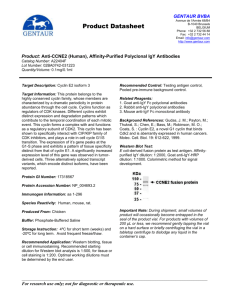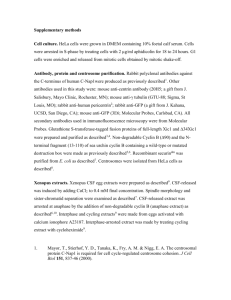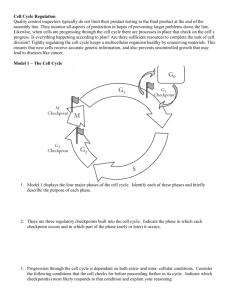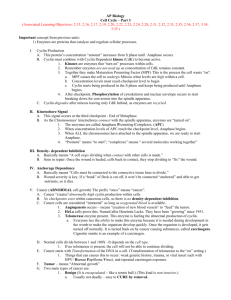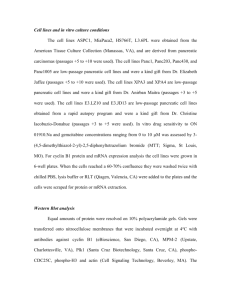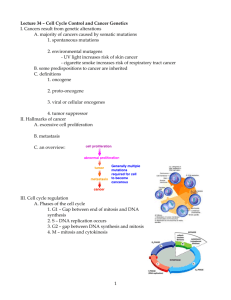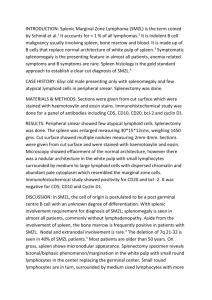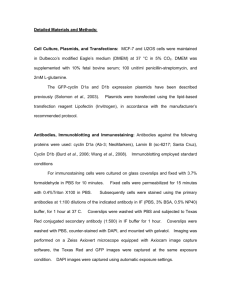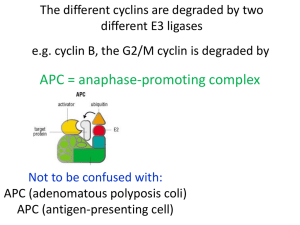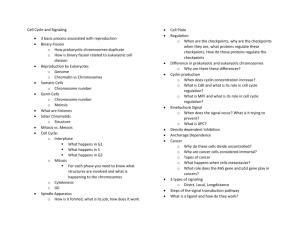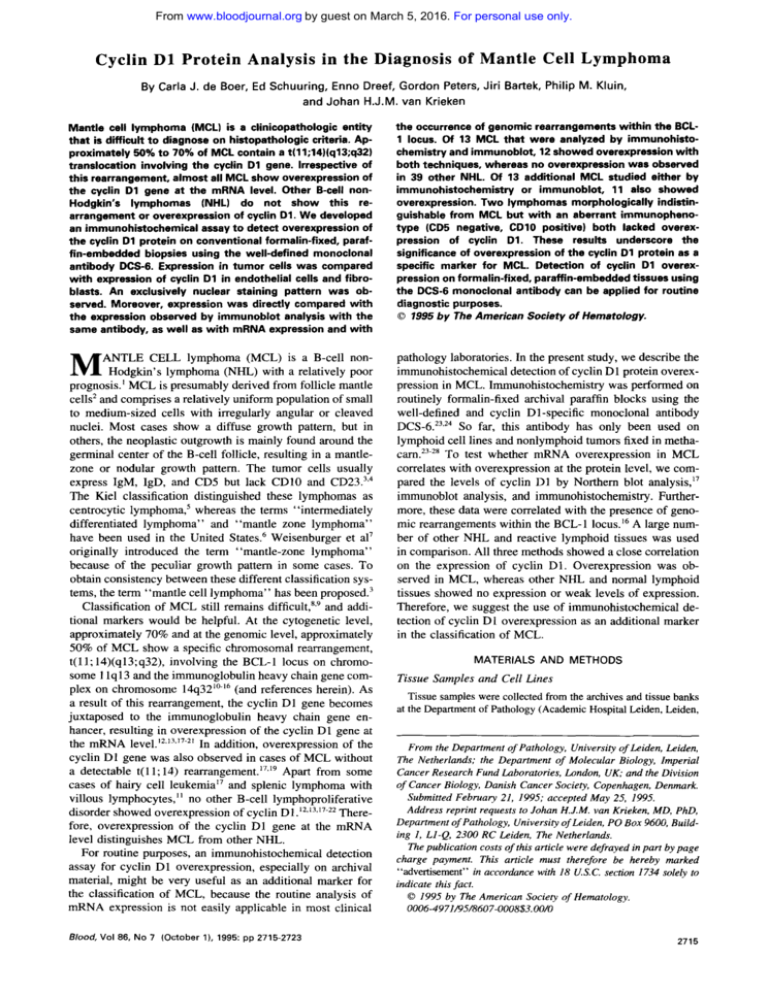
From www.bloodjournal.org by guest on March 5, 2016. For personal use only.
Cyclin D l Protein Analysis in the Diagnosis of Mantle Cell Lymphoma
By Carla J. de Boer, Ed Schuuring, Enno Dreef, Gordon Peters, Jiri Bartek, Philip M. Kluin,
and Johan H.J.M. van Krieken
Mantle cell lymphoma (MCL) is a clinicopathologic entity
that is difficult t o diagnose on histopathologic criteria. Approximately 50% t o 70% of MCL contain a t(11;14)(q13;q32)
translocation involving the cyclin D l gene. Irrespective of
this rearrangement, almost all MCL show overexpressionof
the cyclin D l gene at the mRNA level. Other B-cell nonHodgkin’s lymphomas (NHL) do not show this rearrangement or overexpression of cyclin Dl. We developed
an immunohistochemical assay t o detect overexpression of
the cyclin D l protein on conventional formalin-fixed, paraffin-embedded biopsies using the well-defined monoclonal
antibody DCS-6. Expression in tumor cells was compared
with expression of cyclin D l in endothelial cells and fibroblasts.Anexclusivelynuclear
staining pattern wasobserved. Moreover, expression was directly compared with
the expression observed by immunoblot analysis with the
same antibody, as well as with mRNA expression andwith
the occurrence of genomic rearrangementswithin theBCL1 locus. M 13MCL that were analyzed by immunohistochemistry and immunoblot, 12 showed overexpressionwith
both techniques, whereas no overexpressionwas observed
in 39 other NHL. Of 13 additional MCL studied either by
immunohistochemistry or immunoblot, 11 also showed
overexpression. Two lymphomas morphologically indistinguishable from MCL but with an aberrant immunophenotype (CD5negative,CD10
positive) both lackedoverexpression
of
cyclin Dl. These results underscore the
significance of overexpression ofthe cyclin D l protein as a
specificmarker for MCL. Detection of cyclin D l overexpression on formalin-fixed, paraffin-embedded tissuesusing
the DCS-6 monoclonal antibody can be applied for routine
diagnostic purposes.
0 1995 by The American Societyof Hematology.
M
pathology laboratories. In the present study, we describe the
immunohistochemical detection of cyclin Dl protein overexpression in MCL. Immunohistochemistry was performed on
routinely formalin-fixed archival paraffin blocks using the
well-definedand cyclin Dl-specific monoclonal antibody
DCS-6.23,24So far, this antibody has onlybeenused
on
lymphoid cell lines and nonlymphoid tumors fixed in methac..23-28 To test whether mRNA overexpression inMCL
correlates with overexpression at the protein level, we compared the levels of cyclin Dl by Northern blot analy~is,’~
immunoblot analysis, and immunohistochemistry. Furthermore, these data were correlated with the presence of genomic rearrangements within the BCL-1 locus.’6A large number of other NHL and reactive lymphoid tissues was used
in comparison. All three methods showed a close correlation
on the expression of cyclin Dl. Overexpression was observed in MCL, whereas other NHL and normal lymphoid
tissues showed no expression or weak levels of expression.
Therefore, we suggest the use of immunohistochemical detection of cyclin D l overexpression as an additional marker
in the classification of MCL.
ANTLE CELL lymphoma (MCL) is a B-cell nonHodgkin’s lymphoma (NHL) with a relatively poor
prognosis.’ MCL is presumably derived from follicle mantle
cells2and comprises a relatively uniform population of small
to medium-sized cells with irregularly angular or cleaved
nuclei. Most cases show a diffuse growth pattern, but in
others, the neoplastic outgrowth is mainly found around the
germinal center of the B-cell follicle, resulting in a mantlezone or nodular growth pattern. The tumor cells usually
express IgM, IgD, and CD5 butlack CD10 andCD23.3”
The Kiel classification distinguished these lymphomas as
centrocytic lymphoma,’ whereas the terms “intermediately
differentiated lymphoma” and ‘‘mantle zone lymphoma”
have been used in the United States.6 Weisenburger et al’
originally introduced the term “mantle-zone lymphoma”
because of the peculiar growth pattern in some cases. To
obtain consistency between these different classification systems, the term “mantle cell lymphoma” has been proposed.’
Classification of MCL still remains difficult,’.’ and additional markers would be helpful. At the cytogenetic level,
approximately 70% and at the genomic level, approximately
50% of MCL show a specific chromosomal rearrangement,
t(11;14)(q13;q32), involving the BCL-1 locus on chromosome l lq13 and the immunoglobulin heavy chain gene complex on chromosome 14q3210”6(and references herein). As
a result of this rearrangement, the cyclin Dl gene becomes
juxtaposed to the immunoglobulin heavy chain gene enhancer, resulting in overexpression of the cyclin D l gene at
the mRNA l e ~ e l . ’ * ~ ~ In
’ ~ addition,
~ ” ~ ’ overexpression of the
cyclin Dl gene was also observed in cases of MCL without
a detectable t(l1; 14)
Apart from some
cases of hairy cell leukemia17 and splenic lymphoma with
villous lymphocytes,” no other B-cell lymphoproliferative
disorder showed overexpression of cyclin Dl
Therefore, overexpression of the cyclin Dl gene at the mRNA
level distinguishes MCL from other NHL.
For routine purposes, an immunohistochemical detection
assay for cyclin D l overexpression, especially on archival
material, might be very useful as an additional marker for
the classification of MCL, because the routine analysis of
mRNA expression is not easily applicable in most clinical
.12,‘3317-22
Blood, Vol 86, No 7 (October l), 1995: pp 2715-2723
MATERIALS AND METHODS
Tissue Samples and Cell Lines
Tissue samples were collected from the archives and tissue banks
at the Department of Pathology (Academic Hospital Leiden, Leiden,
From the Department of Pathology, University of Leiden, Leiden,
The Netherlands; the Department of Molecular Biology, Imperial
Cancer Research Fund Laboratories, London, VK; and the Division
of Cancer Biology, Danish Cancer Society, Copenhagen, Denmark.
Submitted February 21, 1995; accepted May 25, 1995.
Address reprint requests to Johan H.J.M. van Krieken. MD, PhD,
Department of Pathology, University of Leiden, PO Box 9600, Building l , Ll-Q, 2300 RC Leiden, The Netherlands.
The publication costs of this article were defrayed in part by page
charge payment. This article must therefore be hereby marked
“advertisement” in accordance with 18 U.S.C. section 1734 solely to
indicate this fact.
0 1995 by The American Society of Hematology.
0006-4971/95/8607-0008~3.00/0
2715
From www.bloodjournal.org by guest on March 5, 2016. For personal use only.
2716
The Netherlands) and other laboratories, where they had been processed including fixation in formalin and snap-freezing with storage
at -70°C. The classification of the MCL andother B-cell NHL cases
used in this study was performed on morphology and immunophenotype, and all cases were reviewed independently by two pathologists
as described previo~sly,'~,'~
according to agreed-upon riter ria.'.^ Our
series of MCL was divided into two groups: (1) classical MCL,
which showed a concordant morphology and immunophenotype
(CD5+ and CD10-), and (2) MCL-like, which morphologically resembled MCL, but showed an aberrant immunophenotype (CDY).
These cases are indicated in this report as MCL-like.
The cell lines used in this study have been described previously."
They were cultured inRPM1 1640 medium containing 10% fetal
calf serum, 100 U/mL penicillin, and 100 pg/mL streptomycin (all
purchased from GIBCO BRL, Gaithersburg, MD) in a humidified
incubator at 37°C with 5% CO2.
Protein Analysis
Preparation of cell extracts. Whole-cell lysates ofthe tumor
tissues (five sections of 20 pm/250 pL lysis buffer) and cell lines
(2 X 10' cells per 100 pL lysis buffer) were obtained by incubation
of cells in lysis buffer (150 mmolL NaCI, 50 mmol/L Tris-HCL
pH 7.5, 1% Triton-X-100, 0.1% sodium dodecyl sulfate [SDS]) supplemented with 5 pg/mL pepstatin (Sigma Alldrich, St Louis, MO),
5 pg/mL leupeptin (Sigma), and 1 mmol/L phenylmethylsulfonyl
fluoride (PMSF; Boehringer Mannheim, Mannheim, Germany). The
supernatant was subsequently used for protein analysis. The protein
concentration was determined with the Bradford protein assay
(Pierce, Rockford, IL). If the concentration of the protein lysate was
too low (less than 2 mg/mL), the lysate was concentrated with a
trichloro-acetic acid (TCA; Baker, Deventer, The Netherlands) precipitation in a final concentration of 10%.TCA precipitation resulted
in a slower migration of the proteins on SDS-polyacrylamide gel
electrophoresis (PAGE) gels as compared with nonprecipitated samD' band shifted to a higher molecular weight (Fig
ples. The p36EYC""
IB). The shift of p36EYc"" was confirmed by analysis of a nonprecipitated and a TCA-precipitated sample of the same lysate.
Immunoprecipitation and immunoblot analysis. Protein A Sepharose (Pharmacia, Uppsala, Sweden) was incubated with 5 pL DCS6 mouse as cite^'^.'^ or 5 pL 287.4 rabbit polyclonal antibodyzyin a
total volume of 500 pL lysis buffer for 1 hour at 4°C. After washing
the beads three times with lysis buffer, 500 pg total cell lysate was
added, and the mixture was incubated for 2 hours at4°C. Beads
were washed with lysis buffer and with phosphate-buffered saline
(PBS) and resuspended in 2 x sample buffer (2X sample buffer:
125 mmol/L Tris-HC1pH 6.8, 2% SDS, 20% glycerol, 20% pmercaptoethanol, 0.1% bromophenol blue).
Whole-cell lysate (50 pg of the cell lines and 200 pg of the tumor
samples) was subjected to immunoblotting. On each gel, cell lysates
of the cell lines UMSCC-2 (po~itivel','~)and Jurkat
were used as references for cyclin Dl expression. Cell lysates were
size-fractionated on either 8.5% or 10% polyacrylamide gels, semidry blotted on polyvinyl difluoride (PVDF) membrane (Millipore,
Bedford, MA) in blot buffer (25 mmol/L Tris, 192 mmol/L glycine,
20% methanol). To check the efficiency of transfer, the membrane
was stained with Ponceau-S (Sigma). The amount of protein loaded
on a gel was analyzed by running a second gel withidentical samples
that was subsequently stained with Coomassie Brilliant Blue
(Sigma).
Immunodetection of cyclin D l . To determine the level of cyclin
Dl protein expression in various NHLand cell lines, membranes
were preincubated in 1% bovine serum albumin (BSA) for 2 hours
at room temperature (RT), then incubated with DCS-6 mouse asciteS27.24 diluted 1:1,OOO in STE (20 mmol/L Tris-HCIpH 7.4, 0.1
mmol/L EDTA, 100 mmoVLNaC1, 0.5% NP-40, 0.1% BSA), and
incubated for 1 hour at RT. After washing, the membrane was incu-
DE BOER ET AL
bated with the conjugated second-step antibody goat-antimouse Ig
alkaline phosphatase (gam-Ig-AP; Promega, Madison, WI), diluted
15,000 in STE, and incubated for 1 hour at RT. After washing the
membrane, substrate incubation was performed in 10 mL substrate
incubation buffer (100 mmol/L Tris-HC1 pH 9.5, 100 mmom NaCI,
5 mmol/L M&) in the presence of 66 pLNBT (nitroblue-tetrazolium; Promega) and 33 pL BCIP (5-bromo-4-chloro-3-indolylphosphate; Promega). The reaction was stopped by washing the membrane in distilled water.
In mostlysates we observed a prominent band of 36 kD. However,
other, weaker bands in the range of 30 to 40 kD were observed in
addition to the p36'Y"i"D'protein, although this antibody was specific
for cyclin Dl.23.24To evaluate crossreactivity with p34c'y'"" and
D3, which are highly expressed in lymphoid cell lines and
p32cyc1'"
t i s s ~ e s , ~ or
' . ~with
' other p30-p40 proteins, several experiments were
performed (data not shown). First, when 5% skimmed milkwas
usedas a blocking agent, only the prominent 36-kD bandand a
weaker band of approximately 38 kD were detectable. In several
reports, the 38-kD band had also been observed and was referred to
as a modified form of the cyclin D l p r ~ t e i n . ~ ~ ,Second,
' ~ , ' ~ immunoblotting of whole-cell lysates of different cell lines and lymphomas
with a rabbit polyclonal antibody against cyclin Dl, 287.4 (with no
crossreactivity against cyclin D2 and D3,29 diluted 1 :l ,OOO) showed
the same staining pattern in the p30-p40 region aswasobserved
with DCS-6. Third, after immunoprecipitation of cell lysates of several cell lines and MCL cases with the DCS-6 antibody and subsequent immunodetection with the 287.4 antibody and vice versa, only
the lower, most prominent band of 36 kD was visible. In the present
study, the level of expression of the cyclin D1 protein was scored
only on the basis of the 36-kD cyclin D l protein band (referred to
as p36cy'""'I). To detect even low levels of expression, 1% BSA
was used as a blocking agent.
Immunohistochemical Staining of Tissue Sections
Tumor samples were fixed in 4% (vol/vol) phosphate-buffered
formalin, dehydrated, and embedded in paraffin. Tumor sections of
4 pm were cut and mountedonto glass slides that hadbeen pretreated
with 2% 3-aminopropyltriethoxysilane (APES; Sigma) and dried at
37°C overnight. Sections were dewaxed in xylene, hydrated in a
graded alcohol series, fixed in methanol ( 5 minutes RT), incubated
in 0.3% Hz02 in methanol (20 minutes at RT), and subsequently
washed with distilled water. Sections were boiled for 25 minutes in
I O mmom citrate buffer pH 6.0 using a microwave oven and cooled
down for at least 2 hours on a magnetic stirrer. The primary antibody,
DCS-6,23,z4wasusedas
culture supematant (diluted 1:SOO and
1:2,500) and incubated overnight at RT. PBS without the primary
antibody was used as a control. An irrelevant antibody of the same
isotype (IgG2A; eg, placental alkaline phosphatase [PLAP]; "858
DAKO, Gloshup, Denmark) was used as an additional control. Sections were washed, incubated with a rabbit-antimouse biotin antibody ( I :200; E-354 DAKO) for 45 minutes at RT, washed again.
and incubated with peroxidase-labeled streptavidine avidin-biotin
complex (ABC-complex; K-377, DAKO). Sections were washed and
developed in diamino-benzidine (DAB) reagents, rinsed in distilled
water, counterstained with 0.1% (wthol) light green (Merck, D m stad, Germany), dehydrated, and mounted with PERTEX (Klinipath,
Duiven, The Netherlands). In each independent experiment, staining
of a normal tonsil served as a control. All samples were independently scored by two pathologists (P.M.K., J.H.J.M.v.K.) without
knowledge of the Southern, Northern, and immunoblot data.
Expression of cyclin Dl was analyzed at bothdilutions. The intensity of nuclear staining of the tumor cells was compared with the
nuclear staining in endothelial cells and fibroblasts. Hence, three
categories of staining intensity were established: -, no staining; +,
equally strong or less than endothelial cells and fibroblasts; and ++,
stronger than endothelial cells and fibroblasts.
From www.bloodjournal.org by guest on March 5, 2016. For personal use only.
CYCLIN D l PROTEIN IN MANTLE
2717 CELL LYMPHOMA
Table 1. Expression of the Cyclin D l Gene in Various Hematopoietic Cell Lines
Cell Line
llql3/BCL-l Breakpoint
Type
Human B cell lines
B-PLL
JVM-2
Pre-B leukemia
Nalm-l
Multiple myeloma
Karpas-620
Transformed follicular lymphoma
DoHH-2
Follicular lymphoma
Beva
Centroblastic
APD
Centroblastic
BSM
B-cell neoplastic
FF129
Other hematopoietic cell lines
Erythroleukemia
Hel-21
CML
K562
AML
AML-193
AML
HL-60
T-ALL
Jurkat
Nonhematopoietic (control) cell lines
Fibroblast, lung
CCD-llLU/CCL-202
Fibroblast
WI-38
Squamous cell carcinoma
UMSCC-2
mRNA
lmmunoblot
+++
++
+++
+++
++
+++
+, MTC
-
+, 36-kb telomeric MTC
-
+, cytogenetically
-
-
- (amplification)
This table summarizes our previous data" on our analysis regarding BCL-1 rearrangements and cyclin D l mRNA expression levels. Immunoblotting results were obtained with the cyclin D l monoclonal antibody DCS-6.
Abbreviations: MTC, major translocation cluster; B-PLL, B-cell prolymphocytic leukemia; CML, chronic myeloid leukemia; AML, acute myeloid
leukemia; T-ALL, T-cell acute lymphocytic leukemia.
RESULTS
Immunoblotting of Cyclin D1 in B-Cell Lymphomas
To assess the levels of cyclin Dl protein in various Bcell lymphomas, we analyzed whole-cell lysates by immunoblotting using a cyclin Dl-specific monoclonal antibody,
DCS-6.23.24
At first instance, we studied the levels of p36cy"i"
in various hematopoietic cell lines withand without a
chromosome 1lql3/BCL- 1 breakpoint and cyclin D l mRNA
(over)expre~sion.'~
To our knowledge, no cell lines are available that are derived from MCL. We, therefore, analyzed
other lymphoid cell lines with a BCL-1 breakpoint (JVM-2,
Karpas-620, and Hel-21; Table 1). In these three cell lines,
overexpression of p36CYc""
DL was observed (Fig 1.4). Two
additional cell lines without a BCL-1 breakpoint (APD,
K562) showed low levels of expression ofp36cy"i" DL,
whereas all other hematopoietic cell lines were negative (Table l, Fig 1A). The levels of expression were in agreement
with the levels observed with Northern blot analy~is.'~
In
the cell line Karpas-620, which harbors a rearrangement at
36 kb telomeric from the MTC and has an additional aberrant
6.0-kb transcript at the mRNA level,I7 an additional cyclin
D l protein of 30 kD was detected as well as the normal 36kD product (Fig 1A). In hematopoietic cell lines, a clear
correlation was observed between overexpression of the
P36cyc"n protein and the presence ofan1
lql3D3CL-1
breakpoint and cyclin D l mRNA overexpression.
The levels of ~ 3 6 ~ ~ were
~ " "subsequently studied in a
large series of MCL and other B-cell NHL, previously analyzed for the presence of a BCL-1 rearrangement16 and for
the level of cyclin D1 mRNA expression." We observed
overexpression in 19 of 21 MCL (Tables 2 and 3, Fig lB),
whereas only one of three MCL-like, 1 of 54 other NHL
(Table 2, Fig lC), and none of the normal lymphoid tissues
(0 of 10; Table 2) showed overexpression. The level of ex-
pression of the ~ 3 6 ' ~ ' "D'" protein was comparable with that
seen with mRNA analysis. Overexpression of the cyclin Dl
protein in MCL was independent of the presence of a detectable BCL-1 breakpoint. This indicates that overexpression
of the cyclin D l protein can be used to distinguish MCL
from other NHL.
Immunohistochemical Staining of the Cyclin D l Protein
Because immunohistochemistry would provide amore
rapid and widely applicable assay for cyclin D l protein expression than immunoblotting, we developed an immunohistochemical staining method for routinely formalin-fixed and
paraffin-embedded tissues. Using culture supernatant of the
DCS-6 antibody in two dilutions, MCL showed a granular
nuclear staining similar to that reported with the same and
other antibodies against cyclin D1.24*25.27.28*35 Furthermore,
a pronounced variation in intensity was observed among
individual tumor cells (Fig 2). A stronger staining intensity
in tumor cell nuclei as compared with normal fibroblasts and
endothelial cells was regarded as overexpression of the
cyclin D l protein. Using this criterium, we observed overexpression of cyclin Dl in 18 of 19 MCL (Tables 2 and 3).
Two dilutions of the primary antibody (1:500 and 1:2,500)
were used because weak expression was observed in all cells
at the highest dilution in two MCL cases (cases 5 and 11).
This low intensity might be explained by differences in tissue
processing, especially because mRNA andimmunoblot analysis showed cyclin Dl overexpression. Two MCL-like
lymphomas and all 48 other NHL showed no overexpression
because a relatively weak staining as compared with endothelial cells and fibroblasts was observed at both dilutions
(Table 2, Fig 3). In addition, immunohistochemistry on 10
normal lymphoid tissues showed no overexpression (Table
2, Fig 4). The expression levels observed with immunohisto-
From www.bloodjournal.org by guest on March 5, 2016. For personal use only.
DE BOER ET AL
2718
"
"
36 kDa4
"
---
"I
C cyclin D l
"
36 kDa
+
c cyclin D l
Fig 1. Cyclin D l protein expression using immunoblot analysis. Whole-cell lysates, 50 p g (cell lines) or 200 p g (tumor samples), were sizefractionated on a 10% (A) or8.5% (B andC) polyacrylamide gel, transferred t o PVDF membrane, and stainedwith theDCS-6 antibody (mouse
ascites). Cell lysates of the cell lines
UMSCC-2 (positive control) and Jurkat (negative control) used
wereas a reference for cyclinD l expression.
Molecular weight is indicated at theleft; protein product is indicated atthe right. (A) Various (nonlhematopoietic cell lines indicated at top.
The arrowhead indicates the additional protein product in the cell line Karpas-620. The double arrowhead indicates the additional protein
product of38 kD (see Materials and Methods). (B) Different samples of MCL are indicated at top.The varying positions of the
cyclin D l protein
are caused by TCA precipitation (see, for instance, p9, p28, and p252). which results in a slower migration (see Materials and Methods). (C)
Other NHL (non-MCL). All other(non-MCL) NHL did not show
overexpression with theexception of CBICC, p47 (indicatedwith an asterisk). LLI
CLL, lymphocytic lymphomalchronic lymphocyticleukemia; IC, immunocytoma; CB, centroblastic lymphoma; CBICC, centroblastic-centrocytic
lymphoma.
chemistry paralleled the results obtained with Northern and
immunoblot analysis (Table 2). However, besides the relative weak staining in all B cells in a tonsil at the lower
dilution, some sporadic cells in the mantle zone and not in
the other areas showed nuclei with high expression (Fig 4).
This finding resembles our previous results; ie, low levels
of cyclin D1mRNA expression in CDI9/CD22 magnetic
bead-purified B cells from fresh tonsils."
Table 3 lists the data for all 26 MCL patients in more
detail. In 13 patients with MCL, all three methods could be
applied. Concordant results were obtained in all cases: 12
of 13MCL showed overexpression by all three methods,
and one MCL (13-B) showed low expression of cyclin Dl
by all three methods. This latter sample is a follow-up biopsy
of patient 13, and the original biopsy sample showed much
higher expression as assessed by immunoblot and Northern
blot analysis (immunohistochemistry was not possible). We
have no explanation for this difference. Eight additional
MCL patients could not be scored with immunohistochemis-
try because of a lack of paraffin blocks (patients 16 through
21) or nonspecific staining deposits (patient 15). From one
patient, the biopsy sample at diagnosis (patient 14-A)
showed overexpression with Northern and immunoblot analysis, but paraffin blocks were lacking. From the follow-up
biopsy (patient 14-B), frozen tissue was no longer available,
and immunohistochemistry showed overexpression; these results are in agreement with those in patients I through 13.
Patient 20, from whom paraffin blocks are lacking, showed
increased mRNA and protein levels of cyclin D1 but not at
follow-up; these results are similar to those of patient 13.
Five MCL patients (patients 22 through 26) were only analyzed by immunohistochemistry. Allfive samples showed
overexpression of cyclin Dl, with a distinct variation among
different tumor cells within the same section, characteristic
for MCL.
Three cases were classified as MCL-like because they
morphologically resembledMCL,but
immunophenotypically were aberrant (CD5- and CDlO+ or -). Patient 27
From www.bloodjournal.org by guest on March 5, 2016. For personal use only.
CYCLIN
D1 PROTEIN IN MANTLE CELL LYMPHOMA
2719
Table 2. Rearrangements in the BCL-1 Locus and Level of Expression of the Cyclin D l Gene in 8 ° K
Northern Blot
Expression of
Cyclin D l t
Southern Blot
Immunohistochemistry*
Immunoblot'
Expression of
Cyclin D l t
Expression of
Cyclin D l t
No. With
Type
MCLS
MCL-like*
Other NHL
CB
CBICC
IC
LUCLL
MALT
Total
Normal lymphoid tissues
Lymph node
Tonsil
Spleen
NO.
Tested
t(ll;14)
No. Tested
High
Low/Neg
No. Tested
High
12
1
21
3
19
1
2
2
21
3
19
1
2
2
19
2
18
0
0
0
0
0
0
12
13
17
8
5
55
8
16
18
7
5
54#
0
0
0
0
1
8
15
18
7
5
53
9
14
12
9
4
0
2
12
13
17
8
5
55
48**
0
9
14
12
9
4
48
ND
ND
ND
2
5
3
0
2
5
3
2
5
3
0
0
0
2
5
3
2
5
3
0
0
0
2
5
3
26
3
16
17
27
12
7
79
ND
ND
ND
16
0
n
i
0
0
0
0
111
0
Low/Neg
No.Tested
High
0
0
0
0
Low/Neg
1
2
Data are listed as separate results regarding Southern, Northern, immunoblot, and immunohistochemical analysis. Southern and Northern
blot data were adapted from de Boer et
Abbreviations: CB, centroblastic lymphoma; CB/CC, centroblastic-centrocytic lymphoma; IC, immunocytoma; LUCLL, lymphocytic lymphoma/
chronic lymphocytic leukemia; MALT, mucosa-associated lymphoid tissue lymphoma; ND, not done.
* Analyzed as described in Materials and Methods.
t Expression levels of cyclin D l are indicated as high, no. with overexpression of cyclin Dl; low/neg, no. with low or undetectable levels of
expression of cyclin D l .
Data are adapted from Table 3; in case of two samples from one patient, the results from the initial biopsy are shown.
§ This sample could not be analyzed for cyclin D l expression because of insufficient material.
]/This sample could not be analyzed for cyclin D1 mRNA expression because of insufficient material, but showed low expression with
immunohistochemistry.
7 This sample could not be scored for mRNA expression; immunohistochemistry could not be performed, and immunoblot showed weak
expression.
# 46 samples were also analyzed by Northern blot.
** 36 samples were also analyzed by both Northern and immunoblot analysis.
*
showed high levels of expression by both Northern and immunoblot analysis, in contrast to results obtained by immunohistochemistry. Most likely, suboptimal tissue processing
caused failure of immunohistochemistry, as both dilutions
of the antibody repeatedly generated only very weak signals.
This case, with a breakpoint within the BCL-1 locus without
Ig heavy chain gene comigration, was CD5- and CDlOnegative, suggesting a variant or atypical MCL.9 The other
two MCL (patients 28 and 29) did not show overexpression
of cyclin Dl by any of the three methods used. It can be
questioned whether these lymphomas really represented
MCL,9because they were CDS-negative and CD10-positive.
Furthermore, case 29 carried a t( 14; 18) at the minor cluster
region of BCL2, suggesting follicular lymphoma rather than
MCL.
DISCUSSION
Cyclin D l , a putative G1 cyclin, has been implicated in
numerous types of neoplasia. Overexpression of cyclin D l
via deregulation may be caused by either chromosomal translocations, such as in parathyroid adenomas36and MCL,I6 or
by amplification of the chromosome 1lq13 region, as in
breast and squamous cell carcinoma^.^^ Considering this
wide spectrum of different genetic aberrations of the cyclin
D l gene and the resulting overexpression of its mRNA, it
is desirable that fast and simple immunohistochemical methods for detection of cyclin Dl overexpression are developed.
A specific chromosomal rearrangement,t(l1; 14) (q13;q32),
involving the BCL-1 locus and affecting the cyclin
Dl gene
has been described in MCL in approximately
50% and 70% of
the cases at the genomic and cytogenetic levels, respectively10-16
(and references herein). Detection of genomic rearrangements
is very laborious because
of the presenceof at least five different breakpoint clusters within the 120-kb BCL-1 locus. Therefore, this method is not easily applicablefor routine diagnostic
purposes to distinguish MCL from other N H L . Recently, we
and others have shown by Northern blot analysis that MCL
overexpressedthecyclin
Dl gene as comparedwithother
B-cell
lymphoproliferative
d i s ~ r d e r s ' ~ ~and
'~
normal
~'~-~~~~
lymphoidtissues.'3317"Overexpressionwasalsopresentin
MCL without a detectable rearrangement in the BCL-1 locus.
This rendersoverexpression ofthecyclin
Dl geneagood
candidate marker for MCL.
Because Northern blot analysis is not easily applicable for
routine diagnostic purposes, we have now investigated the
possible overexpression of cyclin D l at the protein level by
two methods, immunoblotting and immunohistochemistry.
Only a few antibodies have been reported to be cyclin D1speCifiC.23,~,29.3S.38
This is mainly caused by the fact that almost all available cyclin D l antibodies crossreact with cyclin
D2 and/or cyclin D3, which are both highly expressed in
From www.bloodjournal.org by guest on March 5, 2016. For personal use only.
2720
DEBOERETAL
Table 3. Comparative Southern Blot, Northern Blot, Immunoblot, andlor ImmunohistochemicalAnalysis
of Cyclin D l Expression in All MCL Samples
Patient"
Sample
CD5
CD10
IgM
+
+
+
+
+
+
+
+
+
+
+
+
+
+
+
+
+
+
+
+
+
+
+
+
+
+
+
+
+
+
+
+
+
+
+
+
+
+
+
MCL-like: morphologically MCL, immunophenotypically aberrant
+
27
p327
-**
NA
28
P51
29
p307
K
+
+
t(11;14)t
mRNAS
5' D l
MTCJ3' D l
++
++
++
++
++
++
++
++
++
IgL
MCL: morphologically and immunophenotypically concordant
1
+
K
P4
2
+
+
K
p8
3
+
+
K
P11
4
L
p16
5
+
K
p26
6
+
+
L
p28
7
+
+
K
P29
8
K
p30
9-A
+
K
p41
+
9-B
K
p48
10
L
P57
11
p252
K
12
p326
+
L
13-A
L
P1
13-B
L
P12
14-A
L
P9
14-B
L
P20
15
p308
K
16
L
P3
17
L
P10
18
+
L
p14
19
+
K
P21
20-A
+
K
P33
20-8
K
P34
21
+
p306
K
22
L
p215
+
p623
L
23
+
p637
K
24
+
L
p638
25
+
p639
K
26
+
MTC
MTC
MTC
MTC
5' D l
P94PS
P94PS
-
-
-
-
3' D l
-
MTC
MTC
-
MTC
-
+n
MTC
plleh#
-tt
++
++
++
++
++
+
++
++
++
++
++
++
++
++
+
++
NA
NA
-
+
++
++
++
++
++
++
++
-
-
++
Proteins1/500/1
++
++
+
++
-
++
++
++
+
++
+
IHC,
IHC, 1/2,5OOl1
++
++
++
++
++
++
++
++
++
++
++
+
++
++
++
++
++
++
++
++
+
++
NA
NA
++
++
++
++
+
+
ART
ART
++
++
ART
NA
NA
NA
NA
NA
NA
NA
ART
NA
NA
NA
NA
NA
NA
NA
++
++
NA
NA
NA
NA
NA
NA
NA
NA
NA
NA
++
++
++
++
++
++
++
++
++
++
++
+
+
++
+
+
+
+
+
+
ART
ART
Abbreviations: IHC, immunohistochemistry; NA, not analyzed; ART, fixation artefact due to which the sections could notbe scored; -, negative;
+, weak to normal; ++, overexpression.
A and B indicate samples at two different time points for one patient.
t Analyzed as described in de Boer et al."~''
* Analyzed as described in de Boer et al.17
5 Analyzed with DCS-6, mouse ascites.
/IAnalyzed with
DCS-6 culture supernatant.
7 Rearrangement detected by cytogenetics; at the genomic level, no breakpoint was observed with all available breakpoint probes.
# No comigration with Jhwas observed.
** Also negative for IgG, IgD, and IgA.
tt Case with a t(14;18) with a breakpoint at the minor cluster region.
many normal tissues (including lymphoid tissues), tumors,
and (lymphoid) cell lines.31,32.39.40
One of the cyclin Dl-specific antibodies is the monoclonal antibody DCS-6.23,24
This
antibody has been used for immunoblot analysis on cell
lines23*25*26
and for immunohistochemistry of methacam-fixed
tissues, including colorectal car~inoma,~'breast carcinoma,t1,2528 and various normal tis~ues.2~
This antibody,
however, has until nownot been used on formalin-fixed
tissue and not on lymphomas. Only one study has been reported describing the cellular localization of cyclin D l using
immunohistochemistry on formalin-fixed, paraffin-embedded lymphomas.35Using a polyclonal antibody against cyclin
D 1, specific expression of cyclin D 1 was observed in all (15
of 15) MCLand one of seven B-cell small lymphocytic
lymphomdchronic lymphocytic leukemia, but not in 14
other B-cell lymphomas or in seven reactive lymphoid hyperplasia~.~~
In the current investigation, we applied the DCS-6 monoclonal antibody on formalin-fixed, paraffin-embedded material. Furthermore, we directly compared Southern, Northern,
and immunoblot analysis and immunohistochemistry in a
large series of MCL and other lymphomas previously described for genomic rearrangements within the BCL- l locus
Immunohistochemistry
and cyclin D l mRNA e~pression.'"~~
From www.bloodjournal.org by guest on March 5, 2016. For personal use only.
LYMPHOMA
CYCLIN
D1CELL
PROTEIN IN MANTLE
2721
Fig
2. Immunohistochemistry of cyclin D l in MCL. Tumor
sections of a case of MCL were
stained for cyclin D l with the
DCS-6 antibody. (A, B) 1:500 dilution (original magnification
[OM], l 0 0 x and 320 x, respectively); (C, D) 1:2,500 dilution
(OM, 100 x and 320 x , respectively).
3. ImmunohistochemFig
istry of cyclin D l in a follicular
lymphoma. Tumor sections of a
case of follicular lymphoma
were stained for cyclin D l with
the DCS-6 antibody. (A, B) 1:500
dilution (OM, 100 x and 320 x ,
respectively); (C, D) 1:2,500 dilution (OM, l00 x and 320 x, respectively).
4. ImmunohistochemFig
istry of cyclin D l in a tonsil. Sections of atonsil were stained for
cyclin D l with the DCS-6 antibody. (A) 1:500 dilution; OM,l00
x . (B) 1:2,500 dilution, OM, 100
X.
From www.bloodjournal.org by guest on March 5, 2016. For personal use only.
2722
of cyclin D l was first testedon MCLcases withcyclin
D l overexpression as assessed by Northern and immunoblot
analysis andon atonsil as control. TheDCS-6 antibody
was extensively tested on frozen tissue sections and paraffin
sections of formalin-fixedmaterial. Best resultswere obtained with the culture supernatanton formalin-fixed, paraffin-embeddedtissues after antigenretrieval by boilingthe
slidesincitratebuffer.
Usingculture supernatant in two
dilutions, we observed a good correlation between immunohistochemistry, immunoblot analysis, and Northernblot
analysis in our series of MCL and otherNHL. In 13 patients
with CD5+ MCL that could be studiedwith all available
methods, we obtained concordant resultsinall cases concerning the expressionlevels of cyclin D l . Furthermore, the
greatmajorityof
MCL that couldbeeitheranalyzed
by
showed
overeximmunoblot or immunohistochemistry
pression of cyclin D l . These dataindicate that immunohistochemistry is a reliable technique to detect cyclin D l overexpression.
In MCL, immunohistochemistry showed a striking variation between individual tumor cells within the same tumor
sectionatboth dilutions ofthe antibody. Other NHL and
normal lymphoid tissues showed low or undetectable levels
of expression, similartoorlower
than thoseobserved in
endothelial cells and fibrobla~ts.~”~’
Only a very few cells,
predominantly localized in mantle zones of reactive lymph
nodes,tonsils,
and residual mantlezones
offollicular
lymphomas, expressed relatively high levels of cyclin
Dl.
Notably, this expression in other NHL andnormal lymphoid
tissues corroboratesour
previousresultsobtainedwith
Northern blot analysis.17 Using cell separation experiments,
we showed that the weak expression in normal tonsils was
of normal
confined to B cells.I7 In a previousstaining
lymphoid tissues was reported to be absent. Positive staining
ofnormalfibroblasts
and endothelial cellswas notmentioned. The discrepancy with our results may, therefore, be
explained by a higher sensitivity using immunohistochemistry with the DCS-6 antibody.
Collectively, our data showed overexpression
of cyclin D l
in MCL with three different techniques, a good correlation
between immunoblot, immunohistochemistry, and Northern
blotanalysis, and no overexpression ina large seriesof
other(non-MCL) NHL. Most importantly,thecyclin
D1
overexpressionin MCL was independent of the presence
of a detectable BCL-I locus breakpoint, confirming earlier
observations oncyclin
D l mRNA overexpressionusing
that a substanNorthern blot a n a l y ~ i s . ~ ~ . ”This
. ’ ” ~suggests
~
tial number of breakpoints are missed by Southern blot analysis or that mechanisms other than chromosomal translocationsresultintheoverexpressionof
cyclin D l in MCL,
indicating that immunohistochemistry may be paramount in
identifying MCL.
Histologic classification of MCL can bevery difficult, and
distinction from follicular lymphoma as well as other small
B-cell lymphomas may be impossible on morphologiccriteria
This
was exemplified by two
cases
that
showed
a typical morphology of MCL but lacked the CD5 marker,
and both cases expressed CDlO. Furthermore, one case carried the t(l4; 18) translocation, characteristic for follicular
lymphoma. In bothcases,cyclin
D l overexpression was
DE BOER ET AL
absent. This underscores the specificity of our immunohistochemicalassay.The thirdCD5-negative case containeda
breakpoint at the BCL-l locus and showed overexpression
of cyclin D l by Northernblot andimmunoblot analysis,
suggesting a (variant type of) MCL. The failure to detect
overexpression by immunohistochemistry in this particular
sample may be associated with tissue processing.
In comparison with many other patients with small-cell
lymphoma, patients with MCL havea more aggressive clinical behavior, a higher rate of treatment failure, and a shorter
overall survival.’ For that reason, new therapeutic strategies
for MCL are warranted.In combination with other immunophenotypic markers like Ig expression and CD5, CDlO. and
CD23 expression, overexpression of cyclin D1 in MCL as
detected by immunohistochemistryonroutinelyformalinfixed, paraffin-embedded material may be a good additional
marker to distinguish these different lymphoma subtypes.
Overall, our results using immunoblot analysis and immunohistochemistry imply that cyclin D l is overexpressed in almost all MCL, and assessment of cyclin D l protein overexpression would, therefore, be a useful additional diagnostic
marker in identifying MCL from other NHL.
ACKNOWLEDGMENT
We thank the following pathologists for providing us with additional formalin-fixed, paraffin-embedded material: M.C.B. Gorsira
(Diaconessenhuis, Leiden, The Netherlands), J.J. Calame (Rijnland
Hospital, Leiden, The Netherlands), C. Tinga (Bronovo Hospital,
The Hague, The Netherlands), P.J. Spaander (Red Cross Hospital,
The Hague, The Netherlands), P.Blok (Westeinde Hospital, The
Hague, The Netherlands), K. van Groningen (Leyenburg Hospital,
The Hague, The Netherlands), and J. Rahder (Groene Hart Hospital,
Gouda, The Netherlands). We are grateful to Henk van Damme for
assistance with the immunoblot analysis, Sabine Loyson for immunophenotypic analysis of the MCL (both from the Department of
Pathology, University of Leiden, Leiden, The Netherlands), and Dr
G.C. Beverstock (Department of Human Genetics, University of
Leiden) for cytogenetic analysis.
REFERENCES
1. Berger F, Felman P, Sonet A, Salles G, Bastion Y, Bryon PA,
Coiffier B: Nonfollicular small B-cell lymphomas: A heterogeneous
group of patients with distinct clinical features and outcome. Blood
83:2829, 1994
2. Hummel M, Tamaru J, Kalvelage B, Stein H: Mantle cell
(previously centrocytic) lymphoma express Vh genes with no or
very little somatic mutations like the physiologic cells of the follicle
mantle. Blood 84:403, 1994
3. Banks PM, Chan J, Cleary ML, Delsol G, De Wolf-Peeters C,
Gatter K, Grogan TM, Harris NL, Isaacson PG, Jaffe ES, Mason D,
Pileri S, Raltkiaer E, Stein H, Warnke RA: Mantle cell lymphoma.
A proposal for unification of morphologic, immunologic, and molecular data. Am J Surg Pathol 16:637, 1992
4. Shivdasani RA, Hess JL, Skarin AT, Pinkus GS: Intermediate
lymphocytic lymphoma: Clinical and pathologic features of a recently characterized subtype of non-Hodgkin’s lymphoma. J Clin
Oncol 11:802, 1993
5. Stansfeld AC: Updated Kiel classification for lymphomas. The
Lancet 1:292, 1988
6. Berard CW, Dorfman RF: Histopathology of malignant
lymphomas. Clin Heamathol 3:39, 1974
7. Weisenburger DD,
Kim
HG, Rappaport H: Mantle-zone
lymphoma: A follicular variant of intermediate lymphocytic
lymphoma. Cancer 49: 1429, 1982
From www.bloodjournal.org by guest on March 5, 2016. For personal use only.
CYCLIN D l PROTEIN INMANTLE CELL LYMPHOMA
8. Hanis NL, Jaffe ES, Stein H, Banks PM, Chan JKC, Cleary
ML, Delsol G, De Wolf-Peters C, Falini B, Gatter KC, Grogan TM,
Isaacson PG, Knowles DM, Mason DY, Muller-Hermelink H, Pileri
SA, Piris MA, Ralfkiaer E, Warnke RA: A revised European-Amencan classification of lymphoid neoplasms: A proposal from the International Lymphoma Study Group. Blood 84:1361, 1994
9. Zucca E, Stein H, Coiffier B: European lymphoma task force
(ELTF): Report of theWorkshop on Mantle Cell Lymphoma (MCL).
Ann Oncol 5507, 1994
10. Ott MM, Ott G, Kuse R, Porowski P, Gunzer U, Feller AC,
Muller-Hermelink HK: The anaplastic variant of centrocytic
lymphoma is marked by frequent rearrangements of the BCL- I gene
and high proliferation indices. Histopathology 24:329, 1994
1 1. Jadayel D, Matutes E, Dyer MJS, Brito-Babapulle V, Khokar
MT, Oscier D, Catovsky D: Splenic lymphoma with villous lymphocytes: Analysis of BCLl rearrangements and expression of the cyclin
D l gene. Blood 83:3664, 1994
12. Rimokh R, Berger F, Delsol G, Charrin C, Bertheas M,
Ffrench M, Garoscio M, Felman P, Coiffier B, Bryon PA, Rochet
M, Gentilhomme 0, Germain D,Magaud J: Rearrangement and
overexpression of the BCL- IPRAD 1 gene in intermediate lymphocytic lymphomas and in t(l lql3)-bearing leukemias. Blood 81:3063,
1993
13. Raynaud SD, Bekri S, Leroux D, Grosgeorge J, KleinB,
Bastard C, Gaudray P, Simon M: Expanded range of llq13
breakpoints with differing patterns of cyclin Dl expression in Bcell malignancies. Genes Chromosom Cancer 8:80,1993
14. Williams ME, Swerdlow SH, Meeker TC: Chromosome
t(l I ; 14)(q13;q32) breakpoints in centrocytic lymphoma are highly
localized at the BCL-l major translocation cluster. Leukemia 7: 1437,
1993
15. Williams ME, Swerdlow SH, Rosenberg CL, Arnold A: Chromosome 11 translocation breakpoints at the PRADUcyclin D1 gene
locus in centrocytic lymphoma. Leukemia 7:241, 1993
16. de Boer CJ, Loyson S, Kluin PM, Kluin-Nelemans JC, Schuuring E, Van Krieken JHJM. Multiple breakpoints within the BCL1 locus in B-cell lymphoma: Rearrangement of the cyclin Dl gene.
Cancer Res 53:4148, 1993
17. de Boer CJ, Van Krieken JHJM, Kluin-Nelemans JC, Kluin
PM, Schuuring E: Cyclin Dl messenger RNA overexpression as a
marker for mantle cell lymphoma. Oncogene 10:1833, 1995
18. Williams ME, Swerdlow SH: Cyclin D1 overexpression in
non-Hodgkin’s lymphoma with chromosome 11 bcl-l rearrangement. Ann Oncol 5 ~ 7 1 1994
,
(suppl)
19. Rosenberg CL, Wong E, Petty EM, Bale AE, Tsujimoto Y,
Harris NL, Arnold A: PRADl, a candidate BCL-1 oncogene: Mapping and expression in centrocytic lymphoma. Roc Natl Acad Sci
USA 88:9638, 1991
20. Oka K, Ohno T, Kita K, Yamaguchi M, Takakura N, Nishii
K, Miwa H, Shirakawa S: PRADl gene over-expression in mantlecell lymphoma but not inother low-grade B-cell lymphomas, including extranodal lymphomas. Br J Haematol 86:786, 1994
21. Bosch F, Jares P, Campo E, Lopes-Guillermo A, Angel Pins
M, Villamor N, Tassies D, JafTe ES, Montserrat E, Rozman C,
Cardesa A: PRADlkyclin D l gene overexpression in chronic
lymphoproliferative disorders: A highly specific marker of mantle
cell lymphoma. Blood 84:2726, 1994
22. Raffeld M, Sander CA, Yano T, Jaffe ES: Mantle cell
lymphoma: An update. Leuk Lymphoma 8:161, 1992
23. Lukas J, Pagano M, Staskova 2, Draetta G, Bartek J : Cyclin
D l protein oscillates and is essential for cell cycle progression in
human tumour cell lines. Oncogene 9:707, 1994
24. Bartkova J, Lukas J, Strauss M, Bartek J: Cell cycle-related
variation and tissue-restricted expression of human cyclin D l protein. J Pathol 172:237, 1994
25. Bartkova J, Lukas J, Muller H, Lutzhoft D, Strauss M, Bartek
2723
J: Cyclin Dl protein expression and function in humanbreast cancer.
Int J Cancer 57:353, 1994
26. Lukas J, Jadayel D, Bartkova J, Nacheva E, Dyer MJS,
Strauss M, Bartek J: BCL-l/cyclin Dl oncoprotein oscillates and
subverts the G1 phase control in B-cell neoplasms carrying the
t(l1; 14) translocation. Oncogene 9:2159, 1994
27. Bartkova J, Lukas J, Strauss M, Bartek J: The PRAD-l/cyclin
D1 oncogene product accumulates aberrantly in a subset of colorectal
carcinomas. Int J Cancer 58568, 1994
28. Gillett C, Fantl V, Smith R, Fisher C, Bartek J, Dickson C,
Barnes D, Peters G: Amplification and overexpression of cyclin D1
in breast cancer detected by immunohistochemical staining. Cancer
Res 54:1812, 1994
29. Bates S , Bonetta L, MacAllan D, Parry D, Holder A, Dickson
C, Peters G: CDK6 (PLSTIRE) and CDK4 (PSK-J3) are a distinct
subset of the cyclin-dependent kinases that associate with cyclin Dl.
Oncogene 9:7 I, 1994
30. Seto M, Yamamoto K, Iida S, Aka0 Y, Utsumi KR, Kubonishi
I, Miyoshi I, Ohtsuki T, Yawata Y, Namba M, Motokura T, Arnold
A, Takahashi T, Ueda R: Gene rearrangement and overexpression
of PRADl in lymphoid malignancy with t(1l; 14)(q13;q32) translocation. Oncogene 7: 1401, 1992
31. Palmer0 I, Holder A, Sinclair AJ, Dickson C, Peters G:
Cyclins D1 and D2 are differentially expressed inhuman
Blymphoid cell lines. Oncogene 8:1049, 1993
32. Meyerson M, Harlow E: Identification of G1 kinase activity
for cdk6, a novel cyclin D partner. Mol Cell Biol 14:2077, 1994
33. Matsushime H, Roussell MF, Ashmun RA, Sherr CJ: Colonystimulating factor 1 regulates novel cyclins during the G1 phase of
the cell cycle. Cell 65:701, 1991
34. Matsushime H, Ewen ME, Strom DK, Kat0 J, Hanks SK,
Roussel MF, Sherr CJ: Identification and properties of an atypical
catalytic subunit (p34PSK”3/~dk4)
for mammalian D-type G1 cyclins.
Cell 71:323, 1992
35. Yang W, Zukerberg LR, Motokura T, Arnold A, Harris NL:
Cyclin D1 (BCL-l, PRADI) protein expression in low-grade B-cell
lymphomas and reactive hyperplasia. Am J Pathol 145:86, 1994
36. Rosenberg CL, Kim HG, Shows TB, Kronenberg HM, Arnold
A: Rearrangement and overexpression of DllS287E, a candidate
oncogene on chromosome 1lq13 in benign parathyroid tumors. Oncogene 6:449, 1991
37. Schuuring E: The involvement of the chromosome llq13
region in human malignancies: Cyclin Dl and EMS1 are two new
candidate oncogenes. Gene 159233, 1995
38. Vallance SJ, Lee H, Roussel MF, Shurtleff SA, Kat0 J, Strom
DK, Sherr CJ: Monoclonal antibodies to mammalian D-type G1
cyclins. Hybridoma 13:37, 1994
39. Buckley MF, Sweeney KJE, Hamilton JA, Sini RL, Manning
DL, Nicholson RI, DeFazio A, Watts CKW, Musgrove EA, Sutherland RL: Expression and amplification of cyclin genes in human
breast cancer. Oncogene 8:2127, 1993
40. Tam SW, Theodoras AM, Shay JW, Draetta GF, Pagano M:
Differential expression and regulation of cyclin Dl protein in normal
and tumor cells: Association with CDK4 is required for cyclin D1
function in G1 progression. Oncogene 9:2663, 1994
41. Jiang W, Kahn SM, Zhou P, Zhang Y, Cacace AM, Infante
AS, Doi S, Santella RM, Weinstein IB: Overexpression of cyclin
D1 inrat fibroblasts causes abnormalities in growth control, cell
cycle progression and gene expression. Oncogene 8:3447, 1993
42. Won K, Xiong Y, Beach D, Gilman MZ: Growth-regulated
expression of D-type cyclin genes in human diploid fibroblasts. Roc
Natl Acad Sci USA 89:9910, 1992
43. Inaba T, Matsushime H, Valentine M, Roussell MF, Sherr
CJ, Look AT: Genomic organization, chromosomal localization, and
independent expression of human cyclin D genes. Genomics 13:565,
1992
From www.bloodjournal.org by guest on March 5, 2016. For personal use only.
1995 86: 2715-2723
Cyclin D1 protein analysis in the diagnosis of mantle cell lymphoma
CJ de Boer, E Schuuring, E Dreef, G Peters, J Bartek, PM Kluin and JH van Krieken
Updated information and services can be found at:
http://www.bloodjournal.org/content/86/7/2715.full.html
Articles on similar topics can be found in the following Blood collections
Information about reproducing this article in parts or in its entirety may be found online at:
http://www.bloodjournal.org/site/misc/rights.xhtml#repub_requests
Information about ordering reprints may be found online at:
http://www.bloodjournal.org/site/misc/rights.xhtml#reprints
Information about subscriptions and ASH membership may be found online at:
http://www.bloodjournal.org/site/subscriptions/index.xhtml
Blood (print ISSN 0006-4971, online ISSN 1528-0020), is published weekly by the American
Society of Hematology, 2021 L St, NW, Suite 900, Washington DC 20036.
Copyright 2011 by The American Society of Hematology; all rights reserved.

